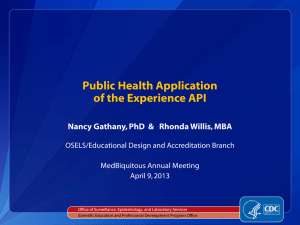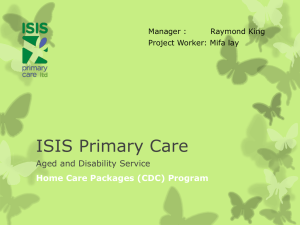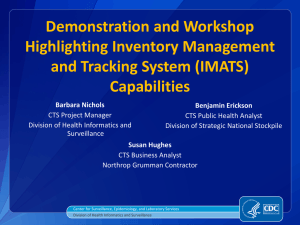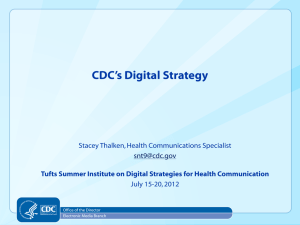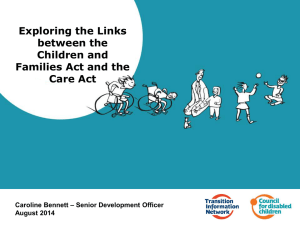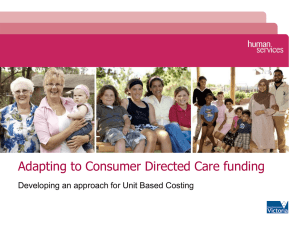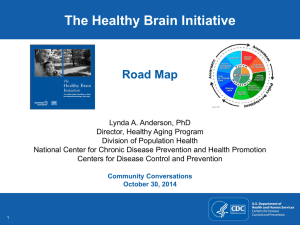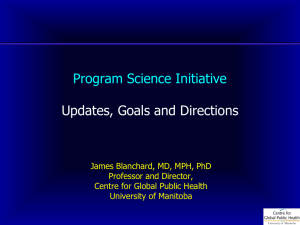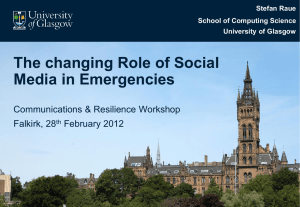Social Media in College Health - American College Health Association
advertisement
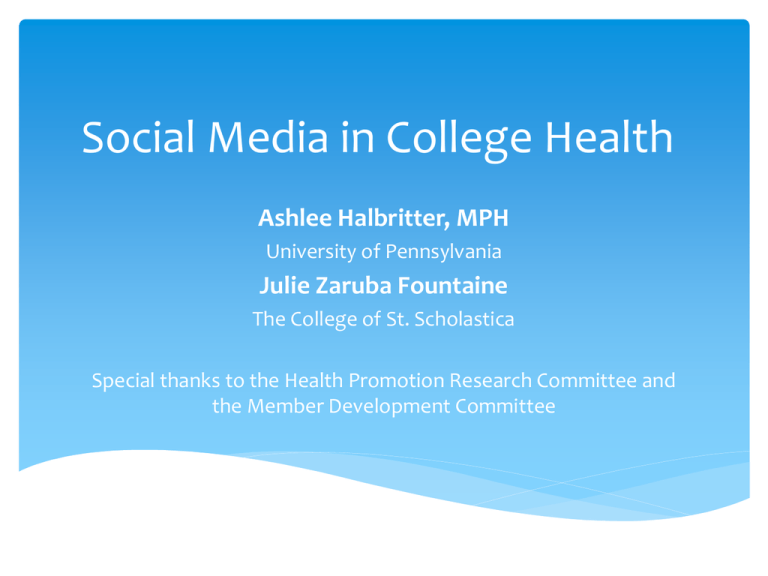
Social Media in College Health Ashlee Halbritter, MPH University of Pennsylvania Julie Zaruba Fountaine The College of St. Scholastica Special thanks to the Health Promotion Research Committee and the Member Development Committee Overview Introduction to Social Media Purpose of Webinar Social Media Platforms Best Practices Evaluating social media efforts Key Indicators Challenges Evaluation Social Media in College Health Examples of Use Process Examples Outcome Examples Questions Introduction to Social Media in College Health Purpose of Webinar Purpose of Webinar To familiarize college health professionals with the knowledge and skills necessary to effectively use and evaluate a social media communication plan Social Media addresses a Healthy Campus 2020 Health Communication/Health Objective: Increase the proportion of students who report receiving information on violence prevention, suicide, tobacco use, alcohol and other drugs, pregnancy prevention, STIs, nutrition, and/or physical activity Why Social Media Matters? According to Nation Survey of Student Engagement (NSSE) Annual Results 2012: 89% of students reported using social media First year students who frequently used social media were more engaged and believed their campus environment to be more supportive Flip side: students who used social media in class felt less connected and reported lower grades Balance is needed to engage students with out distracting them Introduction to Social Media in College Health Social Media Platforms Learning Objective 1: Distinguish between social media platforms Definition Social Media are the platforms that enable the interactive web by engaging users to participate in, comment on and create content as means of communicating with their social graph, other users and the public. Social media has the following characteristics: Heidi Cohen- Riverside Marketing Strategies Social Media Platforms: To help you network Facebook Widely adopted Young generation may leave as the older generation finds it Google+ Ease of use and uncluttered environment Competition from other platforms LinkedIn Most people are on it Most people don’t know how to use it once on MyLife (MySpace?) Easy to use interface Not widely adopted Twitter Used by large segments of the population Can be a distraction; difficult to be “seen” Social Media Platforms: To help you promote events and ideas Search Engines Bing Google Yahoo Blogging Platforms Blogger Tumblr Vox Xanga Joomla Drupal Typepad Wordpress Discussion Board Forums Lefora Zoho Drupal PhpBB Simple Machines Vanila JavaBB vBulletin Social Media Platforms: To help you share Buffer Delicious Digg Instagram Path Pinterest Quora Reddit Scribd StumbleUpon TweetDeck Wikipedia Social Media Platforms: Most Popular Facebook Twitter LinkedIn Google+ Pinterest Tumblr Flickr VK Instagram DeviantArt Introduction to Social Media in College Health Best Practices Learning Objective 2: Discuss the best practices that exist for social media use in health communication Best Practices Tips for Communicating 1. 2. 3. 4. 5. 6. Know your audience-messages should be relevant Keep messages short and engaging Limit the use of acronyms Messages should be easy to understand Proof read the entire draft Use images and statistics to help support your message 7. Answer the question, “Why should I care?” 8. Provide a call to action CDC: www.cdc.gov/socialmedia/tools Best Practices Tips for Communicating Use numbers when they help you make your point GOOD EXAMPLE: Researchers found that 90% of Americans believe the possible harm from vaccines is very small. WEAK EXAMPLE: Researchers found that 90 percent of Americans believe the risk from vaccines is very small. CDC: www.cdc.gov/socialmedia/tools Best Practices Tips for Communicating Shorter is better GOOD EXAMPLE: Stress is normal. It’s a mental or physical reaction to problems people have in their lives. WEAK EXAMPLE: Stress is a prevalent psychological and physical consequence of the everincreasing demands of life. Clear and action-oriented GOOD EXAMPLE: Follow these rules to avoid getting sick from food: Cook meat until it is not pink in the middle. Wash fresh fruit and vegetables completely before you eat them. Keep hot food hot and cold food cold. WEAK EXAMPLE: Following safety precautions can reduce food-borne disease transmission. CDC: www.cdc.gov/socialmedia/tools Evaluating Social Media Efforts Key Indicators Key Indicators Process Are you reaching the target population? Count contacts Do not look for results Conduct throughout the life of the program Impact/Outcome Are there changes in the target population’s knowledge, attitudes, beliefs or behaviors? Did you meet your overall goal? Impact: Baseline and first contact Outcome: Conduct as soon as enough people have participated to get meaningful results CDC Evaluation Framework: http://www.cdc.gov/evaL/framework/index.htm Key Indicators Process Impact/Outcome Changes in awareness, knowledge and/or beliefs Changes in behavior Followers Likes Number of messages sent Number of messages retweeted Evaluating Social Media Efforts Challenges Learning Objective 3: Describe the strengths and challenges associated with health communication through social media Challenges Sharing and Privacy Evaluation Keeping up with the trends Managing multiple accounts Lack of time Evaluating Social Media Efforts Evaluation Learning Objective 3: Outline the evaluation process of a social media communication plan Evaluation Define your social media success Develop measurable goals and objectives Measure engagement Start small Learn to measure results and influence Use measurement to connect Don’t use term “return on investment” Use metrics to learn, improve, and save time CDC: www.cdcnpin.org Evaluation Planning Informatio n sharing Analysis Implementation Metrics Collection CDC: www.cdcnpin.org Evaluation Base evaluation on the goals of the campaign Exposure Engagement Influence Results “Key Aspects to social media evaluation are progressive: You can’t have ENGAGEMENT without EXPOSURE; never get to INFLUENCE and see RESULTS unless you’ve had some ENGAGEMENT with your target audience” CDC: www.cdcnpin.org Social Media in College Health Examples Examples College of St. Scholastica: Develop Communication Plan Hire WellU Marketing Intern: Examples University of Pennsylvania: Develop a Social Media Strategy Content, timing, medium Implement and evaluate plan Examples Process Evaluation Facebook Process: Likes, Individual posts, comments, friends, geographical breakdown, demographics, page views, unique visitors, external referrers Twitter Process: Number of followers, total posts, hashtags, reach, demographics, geographical location, mentions, re-tweets o Resources: Hootsuite, Tweetreach, Twitazlyer, Topsy Examples Process Evaluation LinkedIn Pages: visitors by industry, page performance, total traffic, visitor demographics, followers, links clicked Groups: members, activity (comments/discussions), demographics (location, function, industry) YouTube Subscribers, likes/dislikes, comments, total views, minutes watched, average percentage watches, top contend viewed, geographical location, viewer demographics (age range and gender) o Resources: LinkedIn Analytics, PeopleLinx Examples Process Evaluation Cross Channel Evaluation Tools Google Analytics Omniture Hootsuite Examples Process Evaluation Website Analytics Page views (new v. returning) Page view duration AND Session visit duration Bounce rate (the % of visits that are single page visits) Exit rate (the most “last viewed” page) Frequency/Loyalty (e.g. are the return users coming every day? Once a week? What page(s) are they returning to) Engagement Which pages they are viewing and for how long How they get to our site (Google, from SHS, etc.) Do people visit specific pages at specific times? Which pages are the most popular? How many pages (if any) do readers browse before leaving? Examples Outcome/Impact Evaluation ACHA-NCHA Survey Have you received information on the following topics from your college or university? Are you interested in receiving information on the following topics from your college or university? Patient Satisfaction Survey Sample Survey Focus Groups Message Testing Social Media in College Health Questions THANK YOU! Ashlee Halbritter, MPH University of Pennsylvania ashleeh@upenn.edu 215-746-0810 Julie Zaruba Fountaine The College of St. Scholastica Jzarubafounta@css.edu 218-625-4914


